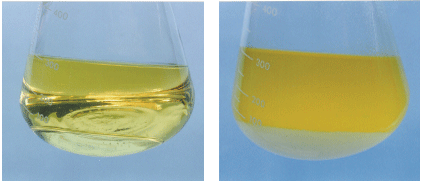Water problems in gasoline containing ethanol
Did you know? In a 10% Ethanol Blend, it takes as little as 18 gallons of water in a 6,000 gallon tanks to cause Phase Separation. In a 2% blend it takes only 3.6 gallons to cause Phase Separation
What is “phase separation”, and how do I deal with it?
If significant amounts of water are present in a fuel tank with gasoline that contains ethanol, the water will be drawn into the fuel until the saturation point is reached for the three-component mixture of water + gasoline + ethanol. Beyond this level of water, phase separation could cause most of the ethanol and water to separate from the bulk fuel and drop to the bottom of the tank, leaving gasoline with a significantly reduced level of ethanol in the upper phase. If the lower phase of water and ethanol is large enough to reach the fuel inlet, it could be pumped directly to the engine and cause significant problems. Even if the ethanol water phase at the bottom of the tank is not drawn into the fuel inlet, the reduced ethanol level of the fuel reduces the octane rating by as much as 3 octane numbers, which could result in engine problems.
The level at which phase separation can occur is determined by a number of variables, including the amount of ethanol, the composition of the fuel, the temperature of the environment and the presence of contaminants. It is very important (A) that the system is inspected for significant quantities of water in the tank before using gasoline with ethanol and (B) to limit exposure of the fuel tank to excess water. If phase separation has occurred, it is necessary to completely remove all free water from the system and replace the fuel before continuing operation. Otherwise, engine problems could occur.
Does ethanol affect horsepower or fuel-efficiency?
Ethanol has a heating value of 76,000 BTU per gallon, which is approximately 30 percent less than gasoline’s heating value (which is approximately 109,000 to 119,000 BTU/gal). The result is E-10 gasoline should yield slightly lower mileage – a decrease of approximately 3 percent. Fuels containing higher levels of ethanol will have a corresponding reduction in mileage. For example, E85 fuels produce mileage approximately 30 percent less than gasoline.
What are the characteristics of ethanol?
Ethanol is an oxygenated hydrocarbon compound that has a high octane rating and therefore is useful in increasing the octane level of unleaded gasoline. The EPA, the agency responsible for setting some of the requirements for all gasoline used in the U.S., has allowed the use of ethanol in gasoline at levels up to 10 percent as an octane enhancer and as an oxygenate to provide beneficial clean-burning combustion characteristics that help improve some emissions.
Ethanol is hygroscopic (it has an attraction for water) and will more readily mix with water than with gasoline. It has different solvency behaviors than does gasoline, which allows it to loosen rust and debris that might lay undisturbed in fuel systems. And it can more readily remove plasticizers and resins from certain plastic materials that might not be affected by gasoline alone. Loose debris will plug filters and can interfere with engine operation. Additionally, ethanol is corrosive to some metals, especially in combination with water. Although gasoline does not conduct electricity well, ethanol has an appreciable capability to conduct electricity and therefore can promote galvanic corrosion.
Two Stroke Engines
Phase Separation in ethanol-blended gasoline, however, can be more damaging than in MTBE blends and straight gasoline. When phase separation occurs in an ethanol blended gasoline, the water will actually begin to remove the ethanol from the gasoline. Therefore, the second phase which can occur in ethanol blends contains both ethanol and water, as opposed to just water in MTBE blends and conventional gasoline. In the case of two-stroke engines, this water-ethanol phase will compete with the blended oil for bonding to the metal engine parts. Therefore, the engine will not have enough lubrication, and engine damage may result.


